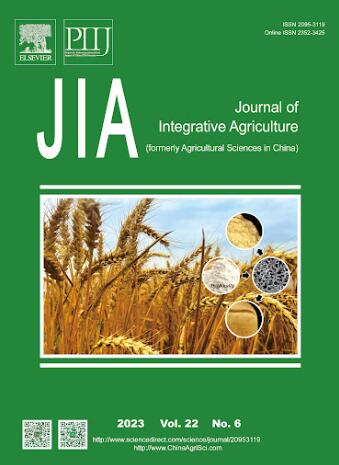合适的有机肥替代配比可稳定中国黄土高原雨养玉米产量并减少气态氮损失
IF 4.4
1区 农林科学
Q1 AGRICULTURE, MULTIDISCIPLINARY
引用次数: 0
摘要
为减少无机肥造成的气态氮(N)流失和土壤退化,施用有机肥已成为玉米生产中越来越受欢迎的替代品。有机肥在改善土壤质量和稳定玉米产量方面发挥着关键作用,但对不同替代率进行细化的研究仍鲜有文献记载。在 2016 年启动的一项长期试验的基础上,2021 年和 2022 年开展了一项实地研究。试验包括五种有机肥氮替代率,每公顷等量投入 200 千克氮:0% 有机肥(T1,100% 无机肥)、50.0% 有机肥+50.0% 无机肥(T2)、37.5% 有机肥+62.5% 无机肥(T3)、25.0% 有机肥+75.0% 无机肥(T4)、12.5% 有机肥+87.5% 无机肥(T5)和不施肥对照(T6)。两年的平均结果表明,T3 和 T1 的粮食产量和生物量分别最高,T1 和 T3 之间没有显著差异。与 T1 相比,12.5%、25.0%、37.5% 和 50.0%的替代率(T5、T4、T3 和 T2)分别显著减少了 8.3%、16.1%、18.7% 和 27.0%的总氮损失(NH、NO)。氮利用效率(NUE)在 T5、T3 和 T1 中较高,三者之间无明显差异。有机肥替代物通过降低铵态氮和碱解氮含量以及增加土壤水分,直接减少了农田中 NH 的挥发和 NO 的排放。这些替代处理通过促进土壤湿度来调节和驯化基因的丰度,从而间接减少了氮氧化物的排放。在中国黄土高原的雨水灌溉玉米田中,37.5%的有机肥替代物通过降低铵态氮和碱解氮含量以及增加土壤水分来减少农田中的NH挥发和NO排放,而土壤水分对和-嗜性基因的丰度具有负向调节作用,从而间接减少了NO的排放。本文章由计算机程序翻译,如有差异,请以英文原文为准。
Suitable organic fertilizer substitution ration stabilizes rainfed maize yields and reduces gaseous nitrogen loss in the Loess Plateau, China
The application of organic fertilizers has become an increasingly popular substitution in maize production to reduce gaseous nitrogen (N) loss and soil degradation caused by inorganic fertilizers. Organic fertilizer plays a key role in improving soil quality and stabilizing maize yields, but studies that refine different substitution rates remain poorly documented. A field study was carried out in 2021 and 2022 based on a long-term trial initiated in 2016. The experiment included five organic fertilizer N substitution rates with equal input of 200 kg N ha: 0% organic fertilizer (T1, 100% inorganic fertilizer), 50.0% organic+50.0% inorganic fertilizer (T2), 37.5% organic+62.5% inorganic fertilizer (T3), 25.0% organic+75.0% inorganic fertilizer (T4), 12.5% organic+87.5% inorganic fertilizer (T5), and no fertilizer control (T6). The average result of two years showed that T3 and T1 had the highest grain yield and biomass, respectively, and there was no significant difference between T1 and T3. Compared with T1, 12.5, 25.0, 37.5, and 50.0% substitution rates (T5, T4, T3, and T2) significantly reduced total nitrogen loss (NH、NO) by 8.3, 16.1, 18.7, and 27.0%, respectively. Nitrogen use efficiency (NUE) was higher in T5, T3, and T1, and there was no significant difference among them. The organic fertilizer substitution directly reduced NH volatilization and NO emission from farmland by lowering ammonium nitrogen and alkali-dissolved N content and by increasing soil moisture. These substitution treatments reduced NO emissions indirectly by regulating the abundance of and -harboring genes by promoting soil moisture. The 37.5% of organic fertilizer substitution reduces NH volatilization and NO emission from farmland by decreasing ammonium nitrogen and alkali-dissolved N content and increasing moisture which negatively regulate the abundance of and -harboring genes to reduce NO emissions indirectly in rainfed maize fields on the Loess Plateau of China.
求助全文
通过发布文献求助,成功后即可免费获取论文全文。
去求助
来源期刊

Journal of Integrative Agriculture
AGRICULTURE, MULTIDISCIPLINARY-
CiteScore
7.90
自引率
4.20%
发文量
4817
审稿时长
3-6 weeks
期刊介绍:
Journal of Integrative Agriculture publishes manuscripts in the categories of Commentary, Review, Research Article, Letter and Short Communication, focusing on the core subjects: Crop Genetics & Breeding, Germplasm Resources, Physiology, Biochemistry, Cultivation, Tillage, Plant Protection, Animal Science, Veterinary Science, Soil and Fertilization, Irrigation, Plant Nutrition, Agro-Environment & Ecology, Bio-material and Bio-energy, Food Science, Agricultural Economics and Management, Agricultural Information Science.
 求助内容:
求助内容: 应助结果提醒方式:
应助结果提醒方式:


